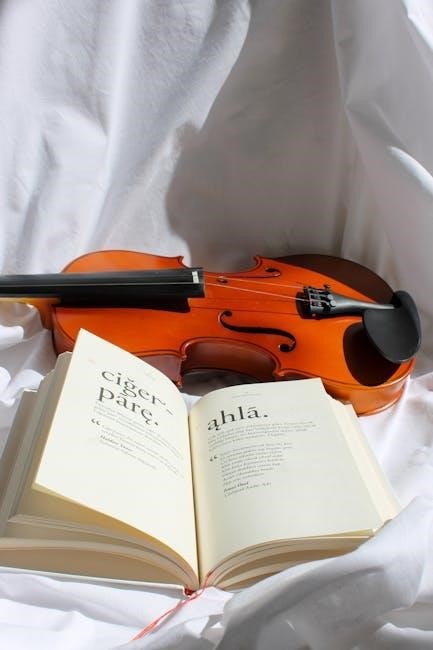Suzuki Violin School Volume 6 is a pivotal milestone in the Suzuki Method curriculum, introducing advanced technical challenges and nuanced musicality. It features works like La Folia and Handel’s Sonata, fostering artistic expression and technical mastery, while the revised edition enhances clarity and interpretation, making it indispensable for aspiring violinists.
Overview of the Suzuki Method
The Suzuki Method, developed by Shinichi Suzuki, is a renowned music education approach emphasizing ear training, parent involvement, and a nurturing environment. It begins with young children, fostering musical understanding through immersion and repetition. The method’s core belief is that every child can learn, mirroring language acquisition. Key elements include starting at a young age, using a standardized repertoire, and encouraging parental participation. This approach cultivates both technical skill and musical sensitivity, preparing students for advanced pieces like those in Volume 6, while maintaining a focus on enjoyment and personal growth through music.
Significance of Volume 6 in the Suzuki Curriculum
Volume 6 holds a pivotal role in the Suzuki curriculum, marking a transition to advanced repertoire while refining technical and musical skills. It introduces complex works like La Folia and Handel’s Sonata, challenging students to master nuanced articulations and bowing techniques. This volume bridges foundational studies with higher-level performance, fostering artistic expression and confidence. The revised edition enhances clarity, ensuring pieces align with pedagogical goals. Volume 6 is a cornerstone for developing mature musicianship, preparing students for the demands of advanced violin literature and fostering a deeper connection to the music they perform.

Contents of Suzuki Violin Book 6
Suzuki Violin Book 6 includes La Folia by A. Corelli, Sonata No. 3 in F Major by G.F. Handel, Allegro by J.H. Fiocco, and Gavotte by J.-P. Rameau.
La Folia by A. Corelli
La Folia, composed by A. Corelli, is a renowned piece featured in Suzuki Violin Book 6. This work, based on a popular Baroque theme, showcases variations that challenge the student technically and musically. Its inclusion in the Suzuki curriculum highlights its educational value, emphasizing proper bowing techniques and musical phrasing. The piece’s intricate structure requires precise intonation and rhythmic accuracy, making it a cornerstone for developing advanced skills in violin performance. It is a testament to Corelli’s mastery and the Suzuki Method’s emphasis on classical repertoire.
Sonata No. 3 in F Major by G.F. Handel
Sonata No. 3 in F Major by G.F. Handel is a key piece in Suzuki Violin Book 6, showcasing Baroque elegance and technical demands. This four-movement work includes Adagio, Allegro, Largo, and Allegro, offering a range of tempos and styles. The Adagio highlights lyrical phrasing, while the Allegro movements test agility and precision. The Largo provides opportunities for expressive tone production. Handel’s Sonata is a cornerstone of the Suzuki curriculum, fostering both technical mastery and artistic interpretation, making it essential for advancing violinists to refine their skills and musicality.
Allegro by J.H. Fiocco
The Allegro by J.H. Fiocco in Suzuki Violin Book 6 is a lively, energetic piece that highlights Baroque musicality. Its technical demands include precise bow control, finger dexterity, and accurate intonation. The Allegro’s rhythmic vitality and melodic charm make it a delightful showcase of the violin’s expressive capabilities. This piece is strategically placed in the curriculum to refine advanced techniques while fostering a deeper connection to the Baroque style. It serves as a bridge between earlier repertoire and more complex works, emphasizing musicality and technical precision in equal measure.
Gavotte by J.-P. Rameau
The Gavotte by Jean-Philippe Rameau is a elegant and refined Baroque piece included in Suzuki Violin Book 6. It is characterized by its dance-like rhythm and lyrical melody, performed in A major at a moderate tempo. This piece emphasizes precise articulation, bow control, and intonation, while also fostering a sense of musical phrasing and dynamic contrast. The Gavotte is a delightful representation of French Baroque style, offering students the opportunity to refine their technical and expressive skills. Its inclusion in Volume 6 highlights its role in bridging technical proficiency with artistic interpretation.
Sonata No. 3 in F Major (Continued)
Sonata No. 3 in F Major by G.F. Handel, continued in Volume 6, builds on the earlier movements with refined musicality and technical demands. The Allegro and Largo movements require precise bow control and intonation, while the final Allegro showcases lively rhythms and articulation. This piece reinforces students’ ability to handle complex phrasing and dynamic contrasts, preparing them for advanced repertoire. The continued sonata emphasizes the development of a polished tone and expressive playing, making it a cornerstone of Volume 6’s curriculum.

Structure and Organization of Volume 6
Volume 6 is logically structured to build on earlier volumes, featuring La Folia, Handel’s Sonata No. 3, and other works, ensuring a balanced progression of technical and musical development.
Technical Challenges and Skill Development
Volume 6 introduces advanced technical challenges, including complex bowings, varied dynamics, and intricate fingerings. Pieces like La Folia and Handel’s Sonata No. 3 demand precise intonation and control. Students develop double stops, chords, and nuanced articulations, refining their bowing techniques. The repertoire also emphasizes consistent tone production across all registers. These challenges foster advanced technical mastery, preparing students for more demanding repertoire. The structured progression ensures a strong foundation for future musical growth and artistic expression, aligning with the Suzuki Method’s emphasis on gradual skill development.
Musical Elements and Artistic Expression
Volume 6 enriches musicality through nuanced dynamics, phrasing, and emotional depth. Pieces like La Folia and Handel’s Sonata No. 3 in F Major showcase complex rhythms and expressive contrasts, refining a student’s ability to interpret musical elements. The repertoire emphasizes precise articulation, varied bowing techniques, and tonal control, fostering a deeper connection to the music’s emotional core. The structured progression of these pieces guides students in developing a polished, expressive sound, aligning with the Suzuki Method’s focus on artistic expression and musical understanding.

Revised Edition of Suzuki Violin Book 6
The revised edition introduces Handel’s Sonata No. 3 in F Major, removes Bach, Kreisler, and Kulau pieces, and features updated bowings and fingerings for enhanced clarity and interpretation.
Changes in the Revised Edition
The revised edition of Suzuki Violin Book 6 incorporates significant updates, including the addition of Handel’s Sonata No. 3 in F Major, which adds depth and variety to the repertoire; The removal of pieces by Bach, Kreisler, and Kulau streamlines the content, focusing on core works that enhance technical and musical development. Additionally, the revised edition features updated bowings and fingerings, providing clearer guidance for students and teachers. These changes aim to improve learning outcomes and enrich the artistic experience for violinists progressing through the Suzuki Method curriculum.
Addition of Handel’s Sonata No. 3
Handel’s Sonata No. 3 in F Major was added to Volume 6, replacing earlier pieces by Bach, Kreisler, and Kulau. This sonata, inserted between La Folia and Fiocco’s Allegro, includes four movements: Adagio, Allegro, Largo, and Allegro. Its inclusion enriches the repertoire with Baroque elegance, offering students diverse tempos and styles. The sonata’s structured form and technical demands enhance articulation, phrasing, and dynamic control, preparing students for advanced classical repertoire while deepening their understanding of musical interpretation and historical context.
Removal of Bach, Kreisler, and Kulau Pieces
The revised edition of Suzuki Violin Book 6 removed pieces by Bach, Kreisler, and Kulau to streamline the curriculum. These works were replaced to focus on core Baroque repertoire, aligning with the Suzuki Method’s emphasis on foundational musical education. Handel’s Sonata No. 3 in F Major was added, offering a cohesive and challenging progression. This adjustment reflects the method’s evolving approach to providing students with a structured and enriched learning experience, ensuring a balanced and comprehensive musical development. While these pieces are no longer included, they remain valuable for supplementary study beyond the Suzuki curriculum.
Features of the Revised Edition
The revised edition of Suzuki Violin Book 6 includes updated bowings, fingerings, and enhanced musical interpretation, ensuring clarity and precision. These adjustments aid in refining technique and expression.
Revised Editing of Pieces
The revised editing of pieces in Suzuki Violin Book 6 enhances clarity and musicality. Changes include refined bowings and fingerings, ensuring smoother technical execution and deeper artistic expression. These adjustments align with the Suzuki Method’s emphasis on precise technique and emotional connection to the music. The revisions are designed to guide students in developing a more polished and expressive performance style, making the pieces more accessible while maintaining their artistic integrity. This careful editing supports the method’s goal of nurturing both technical skill and musical understanding in young violinists.
New Bowings and Fingerings
The revised edition of Suzuki Violin Book 6 introduces updated bowings and fingerings, enhancing technical accuracy and musicality. These adjustments provide clearer guidance for students, aiding in smoother execution of complex passages. New fingerings are designed to improve intonation and dexterity, while bowings emphasize expressive phrasing. For instance, in Handel’s Sonata No. 3, the revised bowings facilitate better articulation and tonal production. These changes align with the Suzuki Method’s focus on technical precision and artistic expression, helping students master advanced repertoire with confidence and musical sensitivity. The updated markings ensure a more polished and engaging performance.
Enhanced Musical Interpretation
The revised edition of Suzuki Violin Book 6 places a strong emphasis on enhancing musical interpretation, offering students deeper insights into the emotional and stylistic nuances of the pieces. The updated editing and markings guide students in conveying the expressive qualities of works like Handel’s Sonata No. 3 and Fiocco’s Allegro. This focus on interpretation helps students connect with the music on a more profound level, fostering a richer, more engaging performance. The revisions ensure that technical mastery is balanced with artistic expression, allowing students to develop a more mature and polished sound.

Importance of Piano Accompaniments
Piano accompaniments in Suzuki Book 6 provide harmonic support and rhythmic guidance, enhancing practice and performance. They aid in developing musicality and tempo accuracy, essential for advanced pieces.
Role of Accompaniments in Practice
Piano accompaniments play a vital role in Suzuki Violin Book 6 practice, providing harmonic structure and rhythmic support. They help violinists maintain accurate tempo and intonation while enhancing musical expression. The accompaniments also aid in developing phrasing and articulation, essential for mastering complex pieces like Handel’s Sonata. Additionally, they create a more engaging and immersive practice experience, fostering a deeper connection to the music. The availability of accompaniment PDFs ensures accessibility for students to refine their skills effectively, aligning with the Suzuki Method’s emphasis on collaborative learning and artistic growth.
Enhancing Musicality and Tempo
Piano accompaniments in Suzuki Book 6 significantly enhance musicality and tempo accuracy. By providing a harmonic foundation, they guide the violinist in maintaining steady rhythms and precise timing. This structure allows for better expression of dynamics, phrasing, and articulation, essential for pieces like Handel’s Sonata. The accompaniments also help in developing a strong sense of musical collaboration, encouraging students to play with more confidence and sensitivity. This integration of tempo and musicality fosters a polished performance, aligning with the Suzuki Method’s goal of nurturing both technical skill and artistic interpretation.
Availability of Piano Accompaniment PDFs
Piano accompaniment PDFs for Suzuki Violin Book 6 are readily available online, offering convenient access for both students and teachers. These resources, such as the “Suzuki Violin Method ⏤ Vol 06 ⏤ Piano Accompaniments.pdf,” can be downloaded from platforms like FileRun or through official Suzuki Method International sources. The PDFs are well-formatted and easy to use, providing clear musical notation to support practice. This accessibility ensures that violinists can seamlessly integrate accompaniments into their learning process, enhancing their ability to maintain tempo and dynamics while fostering a richer musical experience.

Significance of Volume 6 in Violin Education
Suzuki Violin Book 6 bridges intermediate and advanced techniques, offering a balanced curriculum that refines technical precision and deepens musical expression, preparing students for complex repertoire.
Transition to Advanced Repertoire
Volume 6 serves as a transitional bridge, guiding students from intermediate to advanced repertoire. Pieces like Handel’s Sonata and Corelli’s La Folia introduce complex rhythms and harmonic depth, preparing students for more demanding works. The revised edition’s inclusion of Handel’s Sonata No. 3 in F Major further enhances this transition, offering a structured approach to mastering Baroque styles. This volume ensures a smooth progression, equipping violinists with the technical and musical skills necessary for tackling advanced repertoire with confidence and artistry.
Development of Artistic Expression
Volume 6 fosters the refinement of artistic expression through its carefully selected repertoire. Pieces such as Handel’s Sonata and Corelli’s La Folia challenge students to explore nuanced phrasing, dynamic control, and emotional depth. The revised edition introduces new bowings and fingerings, guiding students toward a more expressive interpretation of the music. By mastering these works, violinists develop the ability to convey complex emotions and musical storytelling, elevating their performance from technical execution to heartfelt artistry. This volume is instrumental in nurturing the artistic voice of advancing students.
Preparation for Advanced Performances
Suzuki Violin School Volume 6 serves as a critical bridge to advanced repertoire, equipping students with the technical and musical skills necessary for sophisticated performances. The inclusion of works like Handel’s Sonata and Corelli’s La Folia challenges students to refine their intonation, bow control, and vibrato. These pieces demand precise articulation and dynamic contrast, preparing students for the complexities of advanced violin literature. By mastering Volume 6, violinists build confidence and readiness to tackle more demanding concertos and sonatas, ensuring a smooth transition to higher-level performances and competitions.

Resources and Availability
Suzuki Violin School Volume 6 is widely available as a PDF download, including both the violin part and piano accompaniments. Recordings are also accessible for reference and practice;
PDF Downloads and Online Availability
Suzuki Violin School Volume 6 is readily accessible in digital formats. The violin part and piano accompaniments are available as PDF downloads through various online platforms, including Suzuki Method International. This convenient access allows violinists to practice and perform with ease. Additionally, the revised edition’s PDFs include updated bowings and fingerings, enhancing both technical accuracy and musical interpretation. Online availability ensures that students and teachers worldwide can obtain the materials effortlessly, supporting the method’s global popularity and educational impact.
Access to Violin Part and Piano Accompaniments
The violin part and piano accompaniments for Suzuki Violin School Volume 6 are widely available in PDF format. Both the violin solo part and the piano accompaniment can be downloaded from official Suzuki Method International resources and other reputable online platforms. The revised edition includes updated bowings, fingerings, and musical interpretations, ensuring clarity and precision for both students and teachers. This accessibility facilitates seamless practice and performance, making the materials indispensable for violinists progressing through the Suzuki curriculum.
Recordings for Reference and Practice
Recordings for Suzuki Violin School Volume 6 are invaluable for reference and practice. They provide clear demonstrations of each piece, helping students develop accurate intonation, tempo, and phrasing. The recordings also highlight nuances in musical interpretation, such as dynamics and articulation. Available online, these resources allow violinists to practice alongside professional performances, enhancing their understanding and execution of the repertoire. The recordings are particularly beneficial for both students and teachers, offering a comprehensive auditory guide to mastering the pieces in Volume 6.

Interviews and Insights
Interviews with renowned violinists, like Augustin Hadelich, provide unique perspectives on recording Suzuki Violin Books 4-6, offering insights into the challenges and artistic interpretations of Volume 6.
Interview with Augustin Hadelich
Augustin Hadelich shares insights into recording Suzuki Violin Books 4-6, revealing his initial hesitation and eventual delight in exploring the music beyond its pedagogical purpose. He reflects on the technical and artistic challenges of Volume 6, emphasizing the importance of balancing precision with emotional depth. Hadelich also discusses how recording these pieces deepened his understanding of the Suzuki Method’s philosophy, highlighting its focus on nurturing both skill and musicality in young violinists. His perspective offers a unique glimpse into the artistic and technical demands of Volume 6.
Recording Suzuki Violin Books 4-6
Augustin Hadelich’s recording of Suzuki Violin Books 4-6 marks a significant contribution to the Suzuki Method’s resources. Initially, he admitted to not enjoying the older recordings, describing them as overly pedagogical. However, his own recording process revealed the depth and beauty of the repertoire. The project highlights the technical and artistic challenges of these volumes, particularly in Volume 6, where pieces like La Folia and Handel’s Sonata require precision and emotional expression. Hadelich’s recordings provide a modern interpretation, inspiring students and teachers alike to explore the music beyond its methodical origins.
Perspectives on Suzuki Recordings
Suzuki recordings have evolved from strict pedagogical tools to artistically engaging resources, enhancing practice and performance. The revised editions, including Volume 6, reflect updated interpretations and technical nuances. Recordings now emphasize musicality and expression, offering students and teachers valuable references. The availability of digital formats, such as PDFs and online access, ensures accessibility for modern learners. These resources bridge the gap between methodical instruction and artistic interpretation, fostering a deeper connection to the music. The recordings remain essential for understanding and mastering the Suzuki curriculum, particularly for advanced volumes like Book 6.

Pedagogical Insights
The Suzuki Method emphasizes a child-centered approach, fostering talent through nurturing environments. The revised edition of Volume 6 includes updated bowings and fingerings, aiding technical mastery.
Suzuki Method Philosophy
The Suzuki Method, developed by Shinichi Suzuki, is rooted in the belief that every child can learn music. It emphasizes the importance of early education, parental involvement, and a nurturing environment. The method’s core philosophy is “Talent Education,” which focuses on developing the whole child through music, rather than merely teaching technical skills. This approach encourages children to learn by ear and through repetition, mirroring language acquisition. The Suzuki Method also highlights the role of community and group learning, fostering a sense of belonging and shared progress among students.
Teaching Approaches in Volume 6
Volume 6 of the Suzuki Violin School introduces advanced techniques and repertoire, fostering technical mastery and musical refinement. Teachers emphasize precise bow control, finger dexterity, and nuanced phrasing. The revised edition incorporates new bowings and fingerings, enhancing clarity and expression. A focus on dynamic contrast and articulation helps students refine their artistic interpretation. The inclusion of Handel’s Sonata No. 3 and Corelli’s La Folia provides a foundation for understanding Baroque style. Piano accompaniments are integral to practice, aiding tempo accuracy and musicality. This structured approach ensures students develop both technical proficiency and expressive qualities, preparing them for advanced repertoire.
Role of the Teacher and Student
In Volume 6, the teacher plays a crucial role in guiding students through complex repertoire, offering detailed feedback on technique and interpretation. Students are encouraged to practice diligently, refining bowings, fingerings, and musical phrasing. The teacher-student collaboration fosters a deeper understanding of Baroque styles, as seen in Handel’s Sonata and Corelli’s La Folia. Regular practice with piano accompaniments helps students develop tempo accuracy and expressive playing. The teacher also nurtures artistic expression, while the student takes responsibility for mastering challenging passages, ensuring a balanced approach to technical and musical growth.

Legacy and Impact
Volume 6 has profoundly influenced violin education worldwide, offering a structured path to advanced repertoire and remaining a cornerstone for violinists globally.
Historical Significance of Volume 6
Volume 6 holds a notable place in the Suzuki Method’s history, marking a transition to advanced repertoire. Its revised edition, incorporating Handel’s Sonata No. 3 and removing earlier pieces, reflects evolving educational goals. The inclusion of Baroque and Classical works underscores the method’s commitment to fostering technical mastery and artistic expression. This volume bridges the gap to higher-level music, preparing students for complex compositions. Its enduring popularity and pedagogical value highlight its importance in violin education worldwide, solidifying its role as a cornerstone in the Suzuki curriculum.
Influence on Violin Education Worldwide
Volume 6 has profoundly shaped violin education globally, offering a structured approach to advanced learning; Its revised content, including Handel’s Sonata, aligns with modern pedagogical standards, enhancing musicality and technique. The book’s accessibility through PDFs and online resources has made it a universal tool for teachers and students. By fostering a deep understanding of Baroque and Classical styles, Volume 6 continues to inspire violinists, ensuring the Suzuki Method remains a cornerstone in music education, promoting artistic growth and technical excellence across generations and geographies.
Popularity Among Violinists
Suzuki Violin Book 6 is highly regarded among violinists for its structured progression and rich repertoire. The inclusion of pieces like Handel’s Sonata and Corelli’s La Folia appeals to both students and professionals. Its global accessibility through PDF downloads has made it a favorite resource for learners worldwide. The revised edition’s clarity and enhanced musicality further boost its popularity. Many violinists consider it an essential milestone in their musical journey, bridging technique and artistry. Its widespread use underscores its significance as a foundational text in violin education and performance preparation.
Suzuki Violin Book 6 remains a cornerstone of violin education, offering a refined curriculum that bridges technique and artistry. Its revised edition, with enhanced pieces and clarity, ensures continued relevance for violinists worldwide, solidifying its legacy as a foundational text in musical development.
Final Thoughts on Suzuki Book 6
Suzuki Book 6 is a masterful blend of technical and musical challenges, marking a significant step in a violinist’s journey. Its revised content, including Handel’s Sonata and Corelli’s La Folia, offers rich repertoire for advanced study. The enhanced bowings and fingerings in the new edition provide clearer guidance, aiding both students and teachers. This volume not only refines technique but also nurtures artistic expression, making it an essential resource for violinists striving for excellence and a testament to the Suzuki Method’s enduring legacy in music education.
Value for Violinists of All Levels
Suzuki Book 6 offers immense value for violinists across all skill levels, from intermediate to advanced players. Its structured approach and revised content provide a clear progression, while the inclusion of pieces like Handel’s Sonata and Corelli’s La Folia enriches musical understanding. Even seasoned musicians benefit from the refined fingerings and bowings, which enhance technical precision. The availability of piano accompaniments and recordings further supports practice, making Volume 6 a versatile and indispensable resource that aligns with the Suzuki Method’s philosophy of nurturing talent through meticulous guidance and artistic expression.
Continued Relevance in Modern Education
Suzuki Violin School Volume 6 remains a cornerstone in modern violin education, blending timeless repertoire with updated pedagogical insights. The revised edition’s clarity in fingerings and bowings caters to contemporary teaching methods, while its structured progression supports technical and artistic growth. The inclusion of Handel’s Sonata No. 3 and removal of less commonly performed works reflect a modern curriculum. Its digital availability through PDFs and online resources ensures accessibility for today’s learners. This volume’s enduring popularity underscores its adaptability, making it a vital resource for violinists and educators worldwide, aligning with the Suzuki Method’s mission to nurture musical talent effectively.